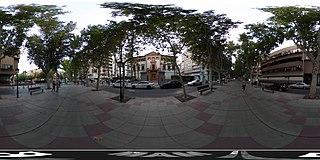
GigaPan Systems is a global, privately held technology company that provides hardware, software, and services to create and share high-resolution, interactive gigapixel panoramic images. The company is headquartered in Portland, Oregon. [1]

GigaPan Systems is a global, privately held technology company that provides hardware, software, and services to create and share high-resolution, interactive gigapixel panoramic images. The company is headquartered in Portland, Oregon. [1]
GigaPan Systems was founded in 2008 as a collaborative project between Carnegie Mellon University and NASA’s Ames Research Center with support from Google. The original GigaPan robotic hardware and related software were devised for NASA's Mars Spirit and Opportunity Rovers, to capture high-definition panoramas of Mars. The development team was led by Randy Sargent, a senior systems scientist at Carnegie Mellon West and the NASA Ames Research Center in Moffett Field, Calif., and Illah Nourbakhsh, associate professor of robotics at Carnegie Mellon in Pittsburgh.
The project has since grown into an independent company offering solutions for capturing gigapixel images.
GigaPan Systems combines high-definition images and panoramas with sharing, tagging and zooming capabilities. The company offers a solution for shooting, viewing and exploring high-resolution gigapixel images in a single system. The GigaPan system includes:

The Ames Research Center (ARC), also known as NASA Ames, is a major NASA research center at Moffett Federal Airfield in California's Silicon Valley. It was founded in 1939 as the second National Advisory Committee for Aeronautics (NACA) laboratory. That agency was dissolved and its assets and personnel transferred to the newly created National Aeronautics and Space Administration (NASA) on October 1, 1958. NASA Ames is named in honor of Joseph Sweetman Ames, a physicist and one of the founding members of NACA. At last estimate NASA Ames has over US$3 billion in capital equipment, 2,300 research personnel and a US$860 million annual budget.

A panorama is any wide-angle view or representation of a physical space, whether in painting, drawing, photography, film, seismic images, or 3D modeling. The word was originally coined in the 18th century by the English painter Robert Barker to describe his panoramic paintings of Edinburgh and London. The motion-picture term panning is derived from panorama.

The Nomad rover is an unmanned vehicle designed as a test for such a vehicle to ride on other planets.
Panoramic photography is a technique of photography, using specialized equipment or software, that captures images with horizontally elongated fields of view. It is sometimes known as wide format photography. The term has also been applied to a photograph that is cropped to a relatively wide aspect ratio, like the familiar letterbox format in wide-screen video.

Motion capture is the process of recording the movement of objects or people. It is used in military, entertainment, sports, medical applications, and for validation of computer vision and robots. In filmmaking and video game development, it refers to recording actions of human actors, and using that information to animate digital character models in 2-D or 3-D computer animation. When it includes face and fingers or captures subtle expressions, it is often referred to as performance capture. In many fields, motion capture is sometimes called motion tracking, but in filmmaking and games, motion tracking usually refers more to match moving.

A gigapixel image is a digital image bitmap composed of one billion (109) pixels (picture elements), 1000 times the information captured by a 1 megapixel digital camera. A square image of 31,623 pixels in width and height is one gigapixel. Current technology for creating such very high-resolution images usually involves either making digital image mosaics of many high-resolution digital photographs or using a film negative as large as 12" × 9" (30 cm × 23 cm) up to 18" × 9" (46 cm × 23 cm), which is then scanned with a high-end large-format film scanner with at least 3000 dpi resolution. Only a few cameras are capable of creating a gigapixel image in a single sweep of a scene, such as the Pan-STARRS PS1 and the Gigapxl Camera.
Maestro (software) was a free program released by NASA to allow users to view photos and daily progress of the Spirit and Opportunity rovers. It served as an activity planner for Mars that utilized a combination of 2D and 3D visuals to track the movement and missions of the Spirit and Opportunity rovers in 2004.
Zoë is a solar-powered autonomous robot with sensors able to detect microorganisms and map the distribution of life in the Atacama Desert of northern Chile, duplicating tasks that could be used in future exploration of Mars. Zoë is equipped with tools and sensors to search for direct evidence of life beneath the surface of the ground. Zoë significantly aids in research needed to study Mars because it acts as a mobile observer and analyzer of any signs of life in a given location. She collects primary data which will help in understanding conditions present on Mars. This project will verify reliability of autonomous, mobile, and scientifically made robots.

Image stitching or photo stitching is the process of combining multiple photographic images with overlapping fields of view to produce a segmented panorama or high-resolution image. Commonly performed through the use of computer software, most approaches to image stitching require nearly exact overlaps between images and identical exposures to produce seamless results, although some stitching algorithms actually benefit from differently exposed images by doing high-dynamic-range imaging in regions of overlap. Some digital cameras can stitch their photos internally.

Photosynth is a discontinued app and service from Microsoft Live Labs and the University of Washington that analyzes digital photographs and generates a three-dimensional model of the photos and a point cloud of a photographed object. Pattern recognition components compare portions of images to create points, which are then compared to convert the image into a model. Users are able to view and generate their own models using a software tool available for download at the Photosynth website.

VR photography is the interactive viewing of panoramic photographs, generally encompassing a 360-degree circle or a spherical view. The results is known as VR photograph, 360-degree photo, photo sphere, or spherical photo, as well as interactive panorama or immersive panorama.

Image Composite Editor is an advanced panoramic image stitcher made by the Microsoft Research division of Microsoft Corporation.

Nearmap Limited is an Australian aerial imagery technology and location data company that provides frequently-updated, high-resolution aerial imagery of 90% of Australia's population, 80% of the United States population, 75% of the New Zealand population, and 65% of Canada's population.
Almost Human: Making Robots Think is a book written by Lee Gutkind founder of Creative Nonfiction. Gutkind spent six years as a "fly on the wall" researcher at the Robotics Institute at Carnegie-Mellon University in Pittsburgh. He observed scientists and students working to design, build, and test robots so advanced that they will one day be able to work alongside or, in some cases, even replace humans. Almost Human is an intense portrait of the robotic subculture and the challenging quest for robot autonomy. Almost Human is 330 pages long and is published by W.W. Norton. In May 2007 Gutkind appeared as a guest author on The Daily Show with Jon Stewart to talk about robots, the future, and his book.

A lunar rover or Moon rover is a space exploration vehicle designed to move across the surface of the Moon. The Apollo Program's Lunar Roving Vehicle was driven on the Moon by members of three American crews, Apollo 15, 16, and 17. Other rovers have been partially or fully autonomous robots, such as the Soviet Union's Lunokhods and the Chinese Yutus. Three countries have had operating rovers on the Moon: the Soviet Union, the United States and China. An Indian mission failed while Japan and Greece currently have planned missions.
GoPro, Inc. is an American technology company founded in 2002 by Nick Woodman. It manufactures action cameras and develops its own mobile apps and video-editing software. Founded as Woodman Labs, Inc, the company eventually focused on the connected sports genre, developing its line of action cameras and, later, video editing software. It is based in San Mateo, California.
Intelligent Robotics Group (IRG) is a division of the Ames Research Center at Moffett Federal Airfield in California's Silicon Valley.

Mars Hand Lens Imager (MAHLI) is one of seventeen cameras on the Curiosity rover on the Mars Science Laboratory mission.

Vandana "Vandi" Verma is a space roboticist and engineer at NASA's Jet Propulsion Laboratory, known for driving the Mars rovers, notably Curiosity and Perseverance, using software including PLEXIL programming technology that she co-wrote and developed.